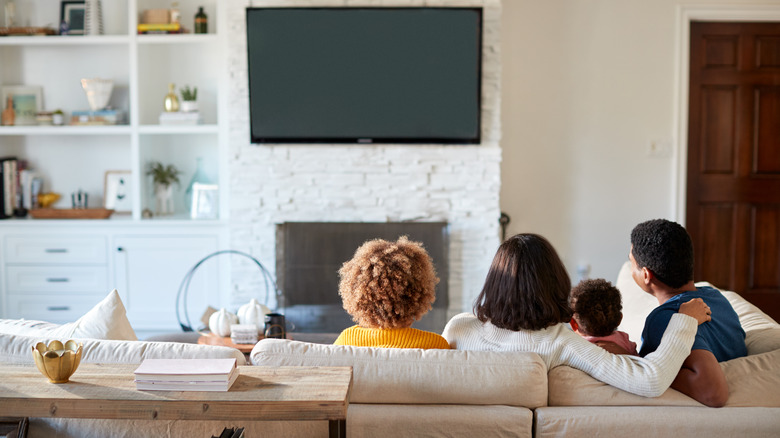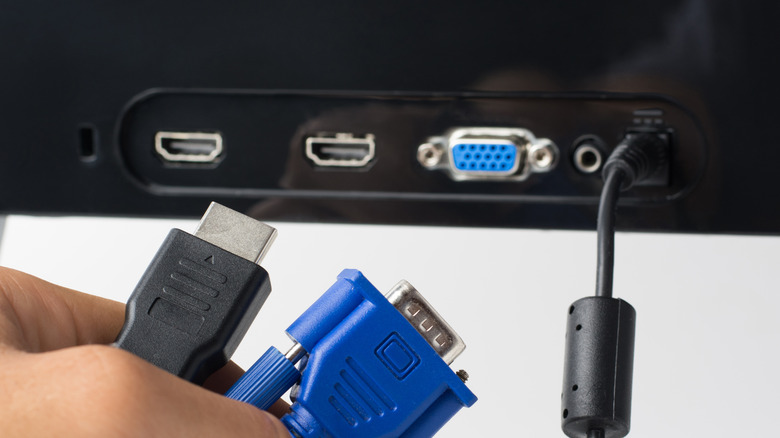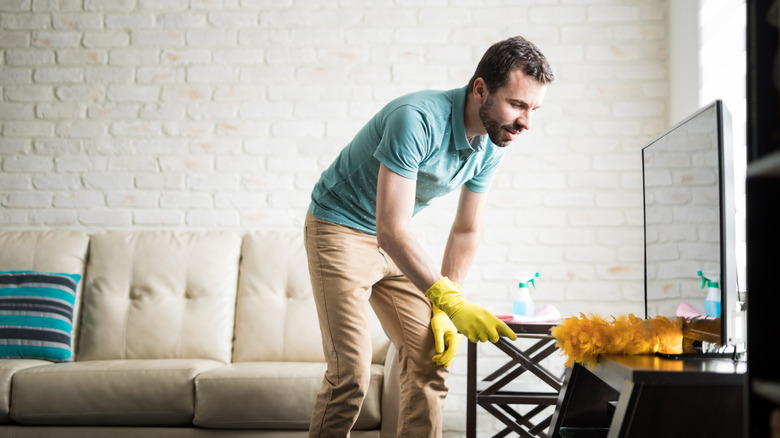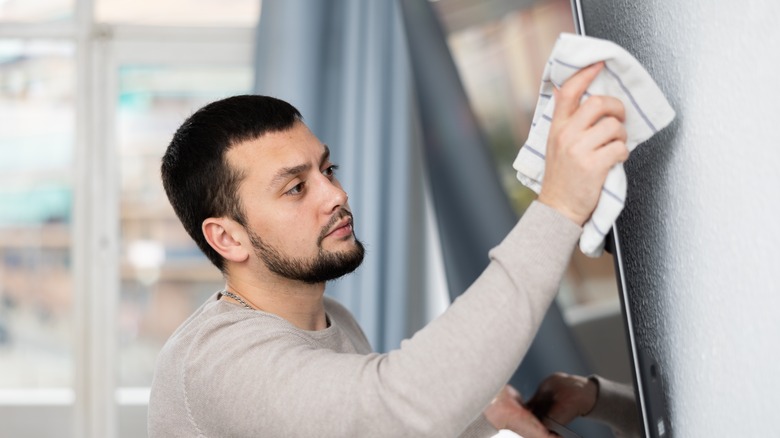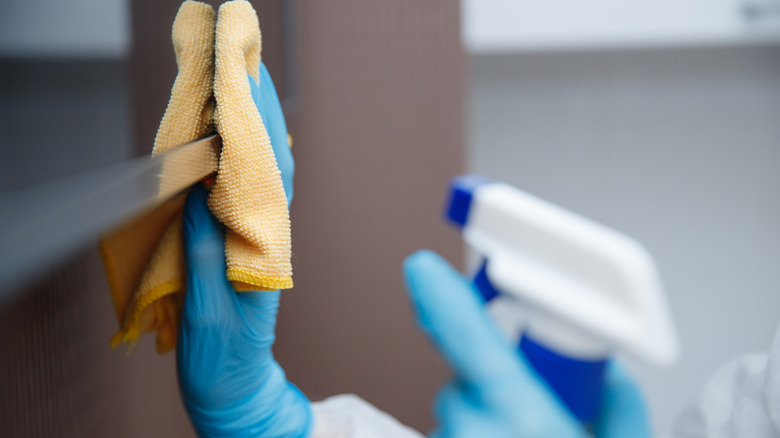5 Mistakes To Avoid While Cleaning Your TV
We may receive a commission on purchases made from links.
Cleaning your TV is something that must be done on a routine basis. You should clean your TV at least once per week in order to maintain the best possible viewing experience for you and your loved ones. However, it's incredibly easy to run into issues when cleaning this essential entertainment device.
The TV sits prominently in most households, and it seems like a straightforward object to clean. However, many issues can come into play while wiping down your TV in order to reduce streaks or remove dust from its surface. For the most part, problems in TV cleaning processes are often the result of simple oversight. Dust, for one thing, plays a particular role in the cleanliness and utility of your device, but it can be easy to forget to clear off the entire surface of the TV. The back, bottom sections, and ports may be easily overlooked without a second glance.
Avoiding these five mistakes while cleaning your TV can make your cleaning process more streamlined and your viewing experience far greater. The average American spends roughly $500 on the purchase of a new TV (via CNET), and with this much effort put into procuring the right screen, it's only right that you make an appropriate effort to keep it clean.
Letting dust collect in the back ports
The first thing you should do when cleaning your TV is attack the dust. Dust collects on all sorts of objects that are stationary in a home. It can be an unsightly addition to a surface, but when it comes to electronic equipment, dust can actually influence the performance of the asset. If it gets trapped in ports, it can degrade the signal coming from a cable box, DVD player, or gaming console. This leads to a worse experience overall for the viewer or gamer.
Fortunately, solving this problem only requires a simple understanding that it exists in the first place. Sourajit reports that a small canister of compressed air is all it takes to blow dust out of any ports and corresponding cables that it may have settled in since the last time you cleaned your TV. Keeping the ports clean and dust-free is a crucial step in the right direction when it comes to cleaning the TV. Starting with the back of the TV can set you off on the right foot as it will ensure that you never forget to clean this critical component. It's easy to overlook the parts of your TV that don't face out toward the couch and larger seating area. But these segments of the TV are just as important as the screen.
Failing to remove layers of dust before polishing
Moving on from the ports, but still focused on the dust, many people forget just how essential it is to dust the TV before they begin any sort of polishing effort. Often, dust is made up of small and relatively soft particles. However, this is not a hard and fast rule and certain dust particles can be dense enough to scratch the screen and other parts of the TV if you don't remove them before wiping the unit with your chosen cleaning product (via Maids).
In the same way that removing dust from the ports is a crucial and yet often overlooked step, dusting off the entire surface of your TV before you begin to polish it and make the screen sparkle once again is an important step that can't be overlooked. As well, dusting a TV will only take you a minute or two, but it can make an enormous difference in the finished product of a cleaned television. Don't forget to tackle this step before moving on to the use of cleaning products and more physically intensive cloth usage.
Scratching your screen with a harsh cloth
Speaking of the cloth that you use to wipe your TV, many homeowners make the mistake of wiping down their television unit with paper towels, regular dishcloths, or even the sleeve of their shirts. Failing to wipe your screen and the rest of the TV with the appropriate type of cleaning cloth can result in scratches or the establishment of increased streaking along the surface (via Rolling Stone). It's critical to use a microfiber cloth if you want a streak-free shine and a pristine-looking device that doesn't accumulate scratches.
You wouldn't clean your car with a paper towel or your shirt sleeve, so you should treat your television in the same regard. Smooth and delicate surfaces like a car's finish or your TV screen require a careful and light touch. These shiny and reflective surfaces can easily pick up smudges, scratches, and other issues if they aren't cleaned with the right kind of equipment. It's easy to reach for whatever cloth material you have available but taking the time to ensure that you're always wiping your screen and the rest of the TV with the appropriate type of cleaning product will guarantee that it remains bright and lustrous for the long term.
Applying too much pressure on the screen's surface
It's also important to know your own strength when cleaning your TV screen. The TV screen in modern units is built out of a dense panel of LED diodes (via Sparkfun). These LEDs are packed immensely tight across the full dimension of your television screen in an effort to provide a sharp and clear picture no matter what kind of show you're watching or game you're playing. TVs are sold today with a metric called dots per inch or pixels per inch (DPI or PPI) to signify how tightly these diodes are packed together, and it's not uncommon to see this figure rise into the hundreds.
But in a change from the tube system of providing a picture to the screen, TVs did away with the heavy and voluminous backing segment as well as the glass screen layer that protected the interior of the unit. Today, TVs have a thin and highly malleable plastic or flexible glass surface rather than the tough glass exterior that once was (via Design Life-Cycle).
While this surface is durable, it remains susceptible to heavy contact and can easily break, rendering the TV useless as the pixels behind it begin to leak. When cleaning your TV screen, you'll need to apply enough pressure to wipe the surface clean but refrain from exerting too much force that might damage the exterior surface or the image-producing cells behind it.
Spraying cleaning solution directly onto the TV
Lastly, Samsung notes that you shouldn't spray cleaning solutions directly onto the TV itself. Instead, you'll want to spray your microfiber cloth and then wipe it across the TV. This will help you to prevent some of these other issues that can come about as a result of improper cleaning practices. Spraying your solution onto the TV's surface can result in overuse of the product, leading to increased wiping or pressure in order to make use of the entire volume of spray solution. Similarly, when spraying the TV itself, you're liable to create a free-running excess of liquid. This can run into ports or down onto the floor, creating more problems than you started the cleaning process with.
The best way to clean your TV is to spray the cloth itself in order to control the amount of solution used. This will give you the best possible outcome and prevent other issues from creeping into your cleaning routine.
